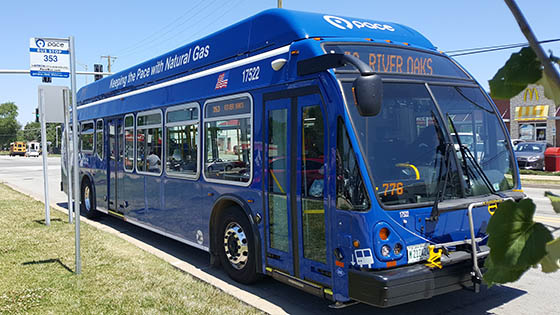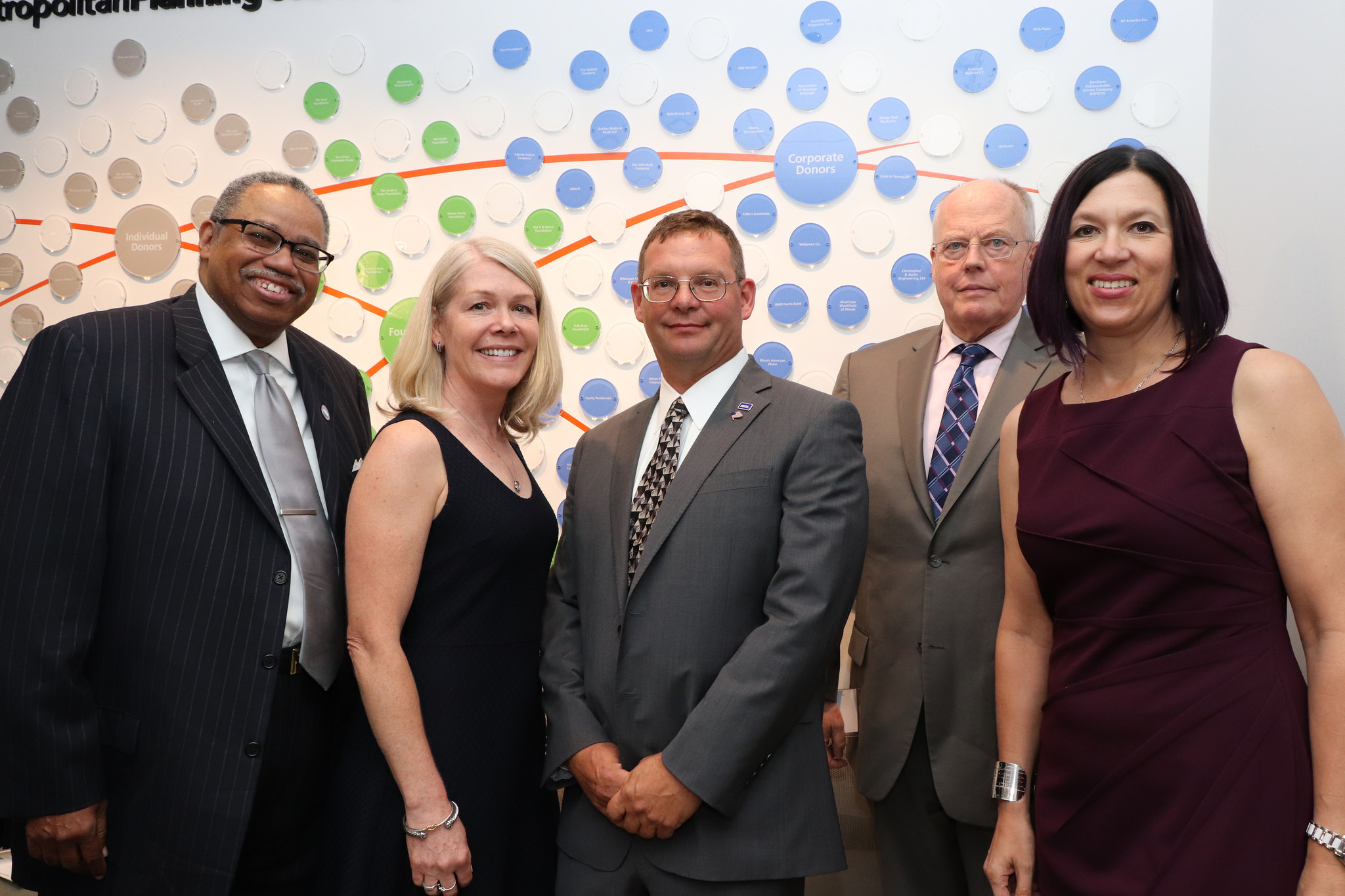The heads of the Chicago area’s four transit agencies all agree: The biggest challenge facing our region’s public transportation system is funding. Due to deferred maintenance caused by revenue shortfalls, our regional transit infrastructure needs an estimated $2-3 billion per year over the next decade to return it to a state of good repair. Money for operations to maintain frequent and reliable service is also in short supply.
Today Regional Transportation Authority president Leanne Redden, CTA president Dorval Carter, Metra CEO Jim Derwinski, and Pace director T.J. Ross discussed the issue at a roundtable hosted by the Metropolitan Planning Council. MPC director of transportation Audrey Wennink moderated the forum.
Wennink began the conversation by noting that an MPC analysis of the CTA and Metra Twitter feeds (Pace has a less active presence on social media) found that each system has an average of six-to-seven delays per day related to infrastructure issues. Over half of CTA delays, and almost two-third of Metra holdups, are caused by infrastructure problems, she said.
During the transit chiefs’ opening remarks, RTA’s Redden argued that the current regional transit funding structure is not sustainable. She noted that if a revenue source could be found to cover the $2-3 billion needed annually for upgrades, “this [would not be] a handout, this delivers return-on-investment that drives the state economy.”
Pace’s Ross noted that the suburban bus system has had to make due without a capital program for the past decade. “We’re at the end of the road,” he said, adding that more investment would help make the regional public transportation system safer, faster, and more reliable.
The CTA’s Carter touted the $8 billion in capital improvements to Chicago’s bus and rail system made under Mayor Rahm Emanuel. He noted that Chicago passed a transit tax-increment financing district to fund the impending overhaul of the North Red Line, as well as a tax on ride-hailing trips to fund CTA infrastructure. But when it comes to financing strategies, he said, “we’re running out of rabbits to pull out of the hat.”
“We’ve had to find innovative ways to do a lot with a little,” echoed Metra’s Derwinski. While finding $2.3 billion annually to get the regional transit system back up to speed may seem daunting, he noted that we really need more money than that to grow the system, as the car-dependent status quo becomes increasingly unsustainable.
Next Wennink mentioned that a funding package for transportation may be advanced in Springfield next year. “How can we show legislators that the funds will be used to truly modernize and innovate the system?” she asked the panelists.
Derwinski pointed to Metra’s plans to upgrade to cars with more seats in order to transport more passengers in a system where the tracks, rail yards, and downtown depots have limited capacity (although he acknowledged that the cars from the railroad’s most recent rolling stock purchase have pros and cons.) He added that recent locomotive upgrades have resulted in a mere six mechanical delays last year among 90,000 runs by those trains. “When you invest in the right technology and use innovation, you’re going to get a return on investment.”
Carter mentioned the CTA’s recent technological accomplishments such as Bus Tracker and Rail Tracker, plus next-stop bus info and automated station info on trains, as well as plans for future improvements to railcars, as evidence that his agency is using funds wisely. He also noted that the transit authority recently built architecturally significant stations at Washington-Wabash in the Loop and Wilson in Uptown.
Ross noted that, to some extent, fare integration has come to the three transit networks via the Ventra payment system, which is a sign of progress. He added that other modes such as paratransit, bike-share, and even station parking should be integrated into the system, and there should also be more emphasis on employers offering transit as a pre-tax benefit on employees’ payroll checks.
Wennink asked the transit chiefs how they plan to promote transit-oriented development and use stations for placemaking, creating safe and vibrant areas. Derwinski credited the village of Glenview with helping to turn the area around the local Metra station into a lively retail and housing hub. Carter pointed again to the Wilson station, which will be getting the Chicago Co-op grocery store, as an example of a CTA stop rehab that’s providing more than just transit access to the community, and noted that planned Garfield and Cottage Grove station rehabs will also be creating new community spaces.
Ross said that express bus service in Barrington will have a positive effect on development in the area. And Redden noted that the Chicago region needs to get serious about value capture, taking revenue from increased real estate values around new stations and investing them back into the system.
Later in the discussion Wennink asked the agency heads about how they plan to deal with the challenge presented by ride-hailing services like Uber and Lyft, whose use has spiked while transit ridership has recently declined. Derwinski said the services have had a mostly beneficial impact on Metra ridership in the suburbs, where they serve as a useful “last mile” solution.
However, Carter jokingly called the relationship between ride-hailing and the CTA “complicated.” “We have to find a way to coexist,” he noted, adding that when the ‘L’ system melts down, Uber and Lyft aren’t able to pick up the slack because they don’t have the capacity of rail cars, and a swarm of ride-hailing vehicles results in gridlock. “We have to decide what kind of community we want… What are the rules for playing in the sandbox?”
When Wennink asked about plans to convert fleets to alternative fuels and electric, Ross reported that Pace is converting many of its buses to low-emission compressed natural gas. He said the choice between CNG and electric is a tough one. “Electric buses need to lose some weight – they’re pretty heavy and expensive.”

Finally the panelist were asked what aspects of the future of transit in the region they’re most excited about. “We can't budget and plan these great projects and great innovations, and grow the system if we can’t actually see the money continually coming in,” Derwinski said. But he noted that peer cities have recently passed taxes to fund transit, and he’s optimistic that there will be leadership in our region to do the same. “If you look at what’s happening now, everything’s pointing toward [the fact that] a solution has to come.”
Carter said he’s excited about the benefits that improvements to transit can have for communities, especially projects like the south Red Line extension that will help “communities that are in desperate need for more investment.”
“I think we’re in an excellent position to make it a faster [regional transit] system,” said Ross, who has previously outlined Pace’s efforts to implement transit-friendly traffic signals and bus rapid transit-like service. Combined with improved safety and reliability, “if we do that, we’re going to have more riders than we know what to do with.”
Redden said that she was heartened by the resiliency of the Chicago region, which has a strong economy, a growing job base, and an impressive talent pool. But she noted that we have a broke state government, and an administration in Washington that, despite rhetoric about an infrastructure package, has been pulling away from investing in infrastructure. Therefore, she said, we need to follow the example of cities like Los Angeles, Philadelphia, and Atlanta and take the matter of funding transit “into our own hands.”






